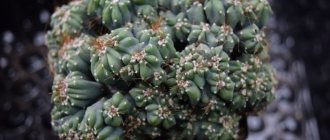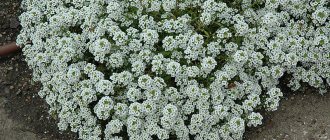Preparing peonies for winter must be done within a certain time frame and correctly. This determines how well the peony bushes will prepare for the next season and will not suffer from frost in winter or from frost in early spring. Caring for peonies in the fall and preparing bushes for winter has a number of features. At this time, 1-1.5 months after flowering, renewal buds are formed and the root system develops. Therefore, it is very important to do everything correctly in order to get lush flowering next season. Peony requires fertilizing and watering, especially during the formation and formation of renewal buds, which occurs shortly after the end of flowering. Therefore, in the fall, peony bushes also need care. During the season, in spring and summer, caring for peonies does not contain any special techniques. This includes watering, loosening the soil, mulching, removing weeds, and trimming fading buds.
Caring for peonies in autumn
What should you do in the fall, when your peony bush is actively preparing for winter?
In the fall, it is recommended to carry out the following measures for caring for peonies:
- Loosening the soil, no deeper than 5 cm within a radius of 50 cm, so as not to damage the roots.
- Mulch the soil around the bushes.
- Remove fallen and dry leaves, petals, faded flowers and buds to prevent fungal diseases
- To prune bushes in autumn, it is advisable to do this as late as possible.
- Shoots and leaves in the fall are cut off as close to the ground as possible and burned.
- Feed the peony bushes.
- If replanting or dividing is required, autumn is the best time for this.
- Abundant watering in late autumn contributes to a good wintering.
What to do if peony...?
Sick during the summer
The most common cause of peony diseases is too acidic soil. In this case, before autumn mulching, add dolomite (dolomite flour at the rate of no more than 0.5 kg per 1 m2) to the soil to deoxidize the soil.
Burn the diseased leaves and treat the bushes with a 1% solution of Bordeaux mixture.
cut off the diseased peony leaves and burn them at the fire of the Inquisition
Feeding peonies in autumn
After active growth and flowering, by autumn the root system of peonies is greatly weakened. Namely, it is at this time that the formation of growth points and roots begins. In order for new roots to successfully form and the plant to enter winter prepared, it needs to be fed.
The root system of peonies accumulates minerals and useful substances in the fall for the active growth of the bush in the spring and the formation of large inflorescences.
In the fall, it is best to feed peonies from mid-September to mid-October, 1-1.5 months before pruning and the first frost. It is at this time that the peony bush most actively accumulates strength and nutrients.
How to feed peonies after transplanting
Many gardeners believe that after transplanting to a new place, peonies do not need feeding. If planting is carried out in an area where peonies have never grown, this statement is true. Plants do well on loamy, ameliorated soils, but worse on sandstone. In any case, they will need a lot of light and water.
Feeding during planting can be limited to manure and ash; in the spring you can also add phosphorus. The main thing is to dig the soil deeply so that the strong root system has somewhere to go deeper. The soil will have to be raised to a level of 80 cm. Manure can be dug up along with the soil. Immediately after planting, only intensive watering is required.
Benefits of autumn feeding of peonies
- In early spring, the buds will be much larger and stronger.
- The peony bush will grow faster and flowering will be more luxuriant.
- The bushes are stronger and quickly increase in size
In autumn, phosphorus-potassium fertilizers are needed. Nitrogen-containing fertilizers are used for spring feeding to enhance the growth of the above-ground part of the plant. When young shoots grow in the fall, they will freeze when it freezes.
Peonies need to be fertilized especially carefully from mid-September to mid-October, preferably 1–1.5 months before pruning. Plants should be fed from the third year after planting.
What should you feed?
Minerals necessary for peonies in autumn - primarily potassium and phosphorus
Like all other flowering plants, peonies need useful substances necessary for the formation of leaves and inflorescences:
- potassium;
- phosphorus;
- nitrogen.
The peculiarity of autumn feeding is that the application of fertilizers containing nitrogen can lead to a deterioration in the frost resistance of plants, therefore, after flowering, peonies require only potassium and phosphorus. As a top dressing, you can use both special mixtures that are sold in gardening stores and natural organic fertilizers.
When to prune peonies in the fall
The most suitable period is considered to be late autumn, before the first frost. This time usually falls at the end of October or beginning of November. Premature pruning will deprive the plant of essential nutrients, and late pruning can cause death. As a last resort, if you need to prune the shrub earlier, leave three or four leaves on each stem. This way, the peony will be able to accumulate strength to lay buds next year.
Autumn pruning of peonies is also required so that in winter the plants do not waste energy on the above-ground part instead of developing the root system. Another reason is fungal and bacterial diseases, which often affect leaves in the fall.
In autumn, pruning peonies should be postponed until the weather gets colder. A sure sign that the plant is ready for pruning is that the branches are lowering to the ground, the leaves are dry and withered; they will no longer be needed. This indicates the end of physiological processes and readiness for the winter rest period. In case of infection, preparation for winter should be carried out earlier by treating the cutting areas and the soil around with a fungicide solution.
Common mistakes
Summer residents who are just starting to grow peonies often make mistakes. The most common ones include:
- cutting leaves in summer. Yellowed leaves often lose their decorative qualities, so gardeners prune them. The process of phytosynthesis of a perennial is carried out in the leaves, so untimely pruning can lead to underdeveloped buds and short flowering in the spring;
- cover with cut tops. Preparation for winter includes shelter, but the tops after pruning are not used for such purposes. Since shoots may contain remains of pests and fungi;
- too intense cover . Perennials tolerate low temperatures well, so too much shelter can cause the bush to begin to rot and die;
- plants are watered until frost. Caring for perennials involves timely watering. However, in the fall, watering is reduced, and a few weeks before frost it stops completely.
To get a healthy flower bush, you must follow all care recommendations. Often minor mistakes in care, especially in the fall, lead to the bushes not forming buds in the spring.
Rules for pruning peonies in autumn
Peony stems are completely cut off in the fall, before the first frost. If you need to prune the bush earlier, leave at least 2-3 leaves on each stem, which will process useful elements from the root system. In this way, the peony will be able to accumulate strength to lay buds next year.
When cutting flowers from a bush in the summer, it is also necessary to leave at least three leaves on the stem.
Sequence of pruning peonies:
- preparation and disinfection of instruments;
- removing shoots, leaving a small stump (1-2cm) so as not to damage the growing points;
- In tree-like peonies, you cannot remove skeletal branches, but only leaves;
- after pruning, sprinkle fertilizers, loosen them, mixing them with the top layer of soil;
- remove and burn plant residues;
Features of preparation of different types
Peonies need to be covered for the winter
The list of preparatory measures depends on the type of plant and its variety, since their level of frost resistance is different, as are their care requirements.
Tree-like
More than 500 varieties are known. The most popular are: Sapphire, Coral Altar, Green Jade, Delawaya, Lemoine.
They are tall (up to 200 cm), the structure of the subshrub is powerful, the branches are fragile. They do not bend, but immediately break, so the first concern is to keep them intact.
First of all, remove all leaves when the air temperature drops to 3-5°. The branches are divided into several bundles and fixed. The root zone is mulched with peat, the branches are covered with non-woven material and spruce branches.
Young bushes are covered with an inverted box or bucket to prevent branches from breaking under the weight of fallen snow. Regardless of the variety, color and size of the buds, autumn care will be the same.
Herbaceous
They have a large number of varieties. Flowers can be completely simple or densely double.
Most often purchased for planting: Avangard, Iceberg, Aza Gray, Watercolor, Buckeye Bell, Victoria, Varenka, Diana, Mercedes.
The crop is cut off almost at the root; covering the remaining parts of the plant is very simple. It is enough to stretch the covering material over the stumps and insulate them with peat or humus. After snow falls, a snowdrift is thrown over the place where the bush grows.
Ito hybrids
They are the most resistant, bred to grow in cold regions, so they do not require additional protection in warm winters.
The following varieties are not afraid of frost: Barzella, Border Charm, Viking Full Moon, Garden Treasure, Dark Eyes, Julia Rose, Kellis Memory.
If the winter is too harsh, shelter is carried out according to the general principle.
Planting peonies in open ground means that they need to be carefully covered in the fall so that they survive the winter period safely.
Mistakes when preparing peonies for winter
The main mistakes when preparing peonies for winter:
- pruning too early, before the first frost, disrupts the formation of renewal buds;
- do not immediately remove withered foliage and cut shoots - the buds and buds are affected by fungal diseases;
- there are not enough nutrients in the soil - there will be few buds;
- if there is an excess of nitrogen, the shoots may be without buds;
- Peonies are not properly covered for the winter.
Peony planting depth
When planting a peony, do not bury the plant's growth buds, otherwise you will not get lush flowering. The correct depth is that the growing points should be 3-5 cm below the soil surface.
- if the peony is planted incorrectly, it needs to be replanted in the fall
- the peony is not planted deeply - the bush suffers from frosts in the spring
- The bush is planted very deeply, many shoots are formed, but few buds.
Disease prevention in autumn
Prevention of fungal diseases of peonies in the fall after leaf fall involves treatment with copper sulfate (3–4%) or Bordeaux mixture (2–3%).
And to increase peony resistance to diseases, it is recommended to use phosphorus-potassium fertilizers and microelements, while eliminating excess nitrogen. The drugs must be alternated.
Answers to frequently asked questions
Does the soil need to be deoxidized?
The area where peonies are grown does not need to be deoxidized. However, if the area is alkaline, it is recommended to scatter dolomite flour under the bushes.
In which regions do you not need to cover peonies?
Preparing perennials for winter ends with shelter. However, for the southern regions, sheltering is not necessary.
Sheltering peonies for the winter
Sheltering peonies is necessary, since the growth buds are located close to the soil surface, at a depth of only 3-7 cm, and they must be protected from frost.
Depending on climatic conditions, covering peonies for the winter is slightly different. But where it is necessary to protect the bushes, the general principles are as follows:
- After pruning the bushes in the fall, they need to be hilled up.
- A layer of mulch at least 15-18 cm thick should be laid on top.
- For tree peonies, the root system is covered with a layer of peat of 20-25 cm, and the stems with lutrasil.
- Sawdust, spruce spruce branches, high-moor peat, dry leaves, humus or compost are used as covering materials.
- You cannot use cut foliage of the peonies themselves or straw, so as not to cause infection.
- In winter, additionally cover the peonies with a layer of snow to protect them from severe cold.
- When removing material in the spring, you can leave some of it as mulch.
How to choose fertilizers for peonies
The first thing you need to pay attention to is the type of soil on the site. If it contains admixtures of sand, then you will have to choose from organic matter what to feed the peonies in the spring for lush flowering in the garden.
It stays in the soil longer and enriches the top layer with humus - waste products of soil bacteria and earthworms. Fertilizers for peonies in the fall and fertilizing after flowering will be useful. Nutrients on sandy loam and sandy soils are added in fractional parts, since they are washed out into the lower layers, where the plant’s root system does not reach.
On heavy clay soils, peonies are fertilized less frequently. Once is enough in spring, summer and autumn. The entire amount of nutrients is introduced at once. On heavy clay soils, it is more important to water the plants on time, since the root system is in the upper layer and suffers from overheating in hot weather.
Video: Feeding peonies in autumn and pruning them
To achieve this, peonies are often mulched in the garden with decorative bark to reduce evaporation. To improve the aeration of clay soil, it is necessary to add more organic matter or sow green manure, which loosens the soil with their roots.











